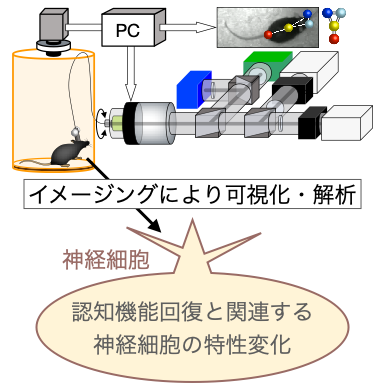渡邉 大

氏名Name
渡邉 大
所属・職名Affiliation, Title, etc.
京都大学大学院医学研究科生体情報科学講座・教授
研究室HPWebsite
一言メッセージShort Message
本プロジェクトでの研究概要Outline of the research in this project
脳のリザバー機能を支える神経細胞の「健常性」を評価する指標を確立し、機能回復に関わる脳の仕組みを細胞レベルで明らかにします。神経細胞は、外部環境からの刺激に加え、生体内および脳内の状態に応じて、特性(回路の接続性や興奮性など)を常に変化させています。私たちはモデル動物を用い、イメージング技術によって認知機能の回復に伴う神経細胞の特性変化を可視化・解析します。
さらに、認知機能の回復を促すと考えられる神経細胞の特性変化を強化する技術を開発します。そして、モデル動物における認知機能の回復を行動レベルで検証し、医療応用に向けた神経細胞の特性制御技術の確立を目指します。

これまで主な研究内容Outline of main research so far
「先進的イメージング技術による認知的柔軟性の神経基盤の解明」
私たちの現実世界は無数の要素で構成されており、絶えず変化しています。これらすべての環境要因を考慮して意思決定を行ったり、問題解決することは、脳の計算能力をはるかに超えています。この困難を乗り越えるために、脳は巧みに要素を絞り込み、限られた情報に基づいて外部環境に関する「内部モデル」を形成します。その結果、私たちは、迅速かつ柔軟に適切な行動をとることができます。しかしながら、脳内にどのように内部モデルが形成され、私たちの意思決定に作用するか詳細は不明でした。この問いに答えるために、私たちは、先端的なイメージング技術を開発し、どのように内部モデルが形成され、さらに行動に反映されるか、明らかにしつつあります。

主な経歴・受賞歴等Career, Awards, etc.
経歴
- 1993-1997
- 京都大学大学院医研究科 博士課程
- 2000
- 博士(医学)
- 1997-2003
- 京都大学大学院医学研究科 生体情報科学講座 助手
- 2003-2005
- 米国California Institute of Technology 研究員
- 2005-2006
- 大阪バイオサイエンス研究所システムズ生物学部門 副部長
- 2006-2014
- 京都大学大学院 生命科学研究科認知情報学講座・医学研究科生体情報科学講座 教授兼担
- 2014年
- 京都大学大学院医学研究科生体情報科学講座 教授専任
受賞歴
- 2013
- 文部科学省 文部科学大臣表彰 科学技術分野
主要業績Major Publications
Okunomiya, T., Watanabe, D., Banno, H., Kondo, T., Imamura, K., Takahashi, R., and Inoue, H. (2025). Striosome Circuitry Stimulation Inhibits Striatal Dopamine Release and Locomotion. J. Neurosci. 45, e0457242024.
https://doi.org/10.1523/jneurosci.0457-24.2024.
Ohmori, H., Hirai, Y., Matsui, R., and Watanabe, D. (2023). High resolution recording of local field currents simultaneously with sound-evoked calcium signals by a photometric patch electrode in the auditory cortex field L of the chick. J Neurosci Meth 392, 109863.
https://doi.org/10.1016/j.jneumeth.2023.109863.
Hamaguchi, K., Takahashi-Aoki, H., and Watanabe, D. (2022). Prospective and retrospective values integrated in frontal cortex drive predictive choice. Proc National Acad Sci 119, e2206067119.
https://doi.org/10.1073/pnas.2206067119.
Sotoyama, H., Namba, H., Kobayashi, Y., Hasegawa, T., Watanabe, D., Nakatsukasa, E., Sakimura, K., Furuyashiki, T., and Nawa, H. (2021). Resting-state dopaminergic cell firing in the ventral tegmental area negatively regulates affiliative social interactions in a developmental animal model of schizophrenia. Transl Psychiat 11, 236.
https://doi.org/10.1038/s41398-021-01346-2.
Okunomiya, T., Hioki, H., Nishimura, C., Yawata, S., Imayoshi, I., Kageyama, R., Takahashi, R., and Watanabe, D. (2020). Generation of a MOR‐CreER knock‐in mouse line to study cells and neural circuits involved in mu opioid receptor signaling. genesis 58, e23341.
https://doi.org/10.1002/dvg.23341.
Abe, K., Matsui, S., and Watanabe, D. (2015). Transgenic songbirds with suppressed or enhanced activity of CREB transcription factor. Proc National Acad Sci 112, 7599 7604.
https://doi.org/10.1073/pnas.1413484112.
Matsui, R., Tanabe, Y., and Watanabe, D. (2012). Avian adeno-associated virus vector efficiently transduces neurons in the embryonic and post-embryonic chicken brain. Plos One 7, e48730.
https://doi.org/10.1371/journal.pone.0048730.
Kinoshita, M., Matsui, R., Kato, S., Hasegawa, T., Kasahara, H., Isa, K., Watakabe, A., Yamamori, T., Nishimura, Y., Alstermark, B., Watanabe, D., and Isa, T. (2012). Genetic dissection of the circuit for hand dexterity in primates. Nature 487, 235 238.
https://doi.org/10.1038/nature11206.
Fujimoto, H., Hasegawa, T., and Watanabe, D. (2011). Neural coding of syntactic structure in learned vocalizations in the songbird. J Neurosci 31, 10023 10033.
https://doi.org/10.1523/jneurosci.1606-11.2011.
Abe, K., and Watanabe, D. (2011). Songbirds possess the spontaneous ability to discriminate syntactic rules. Nat Neurosci 14, 1067 1074.
https://doi.org/10.1038/nn.2869.



